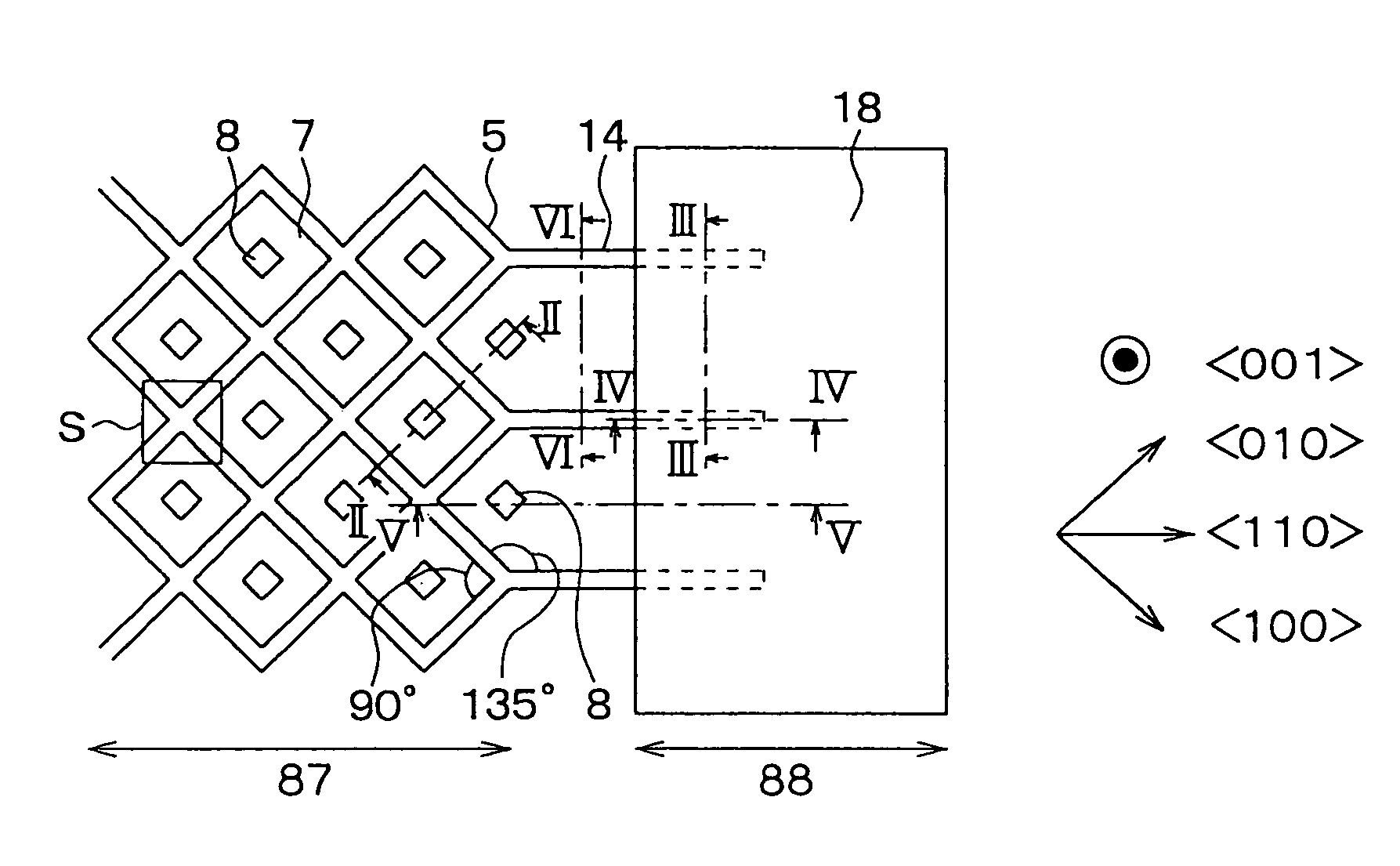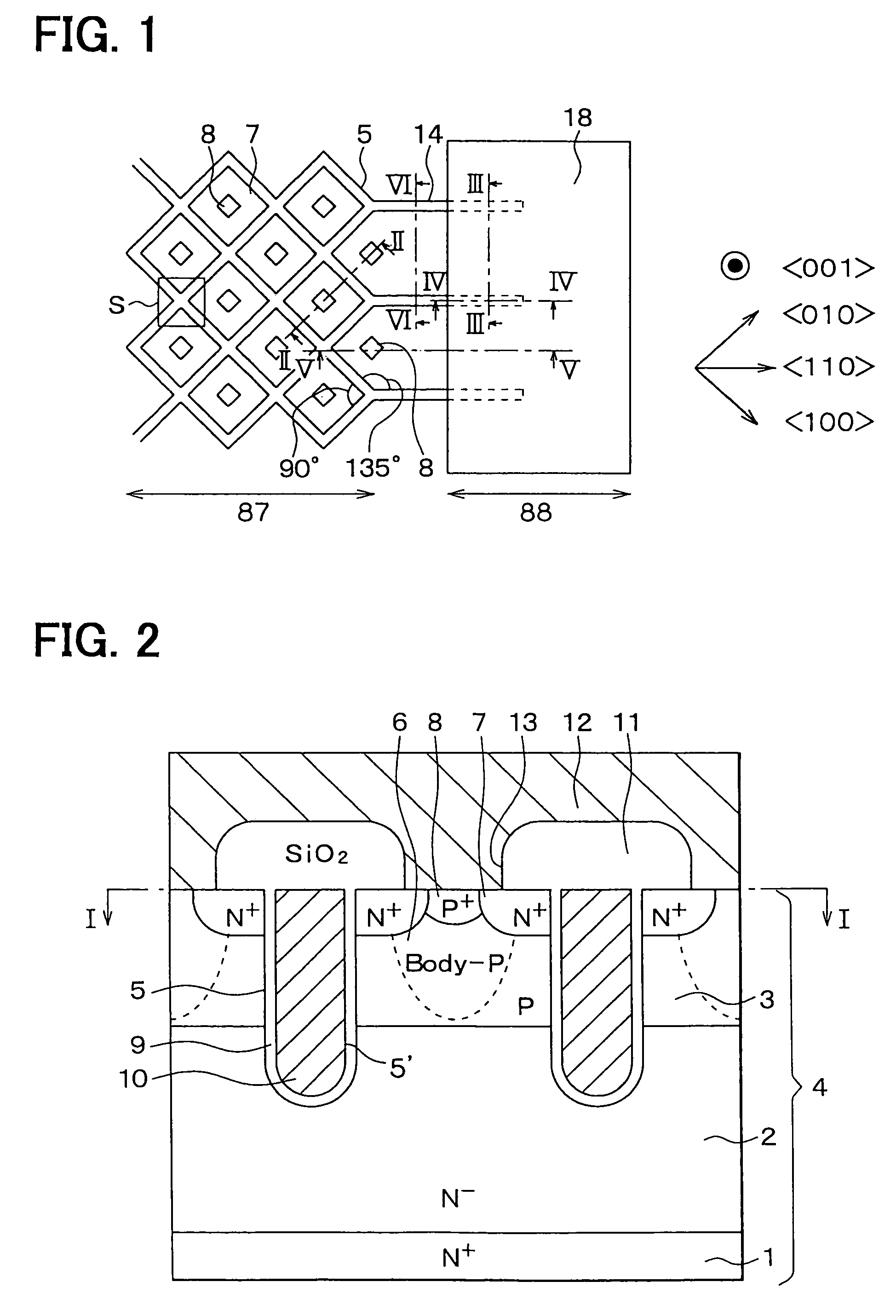Method of producing a semiconductor device
a technology of semiconductor devices and semiconductors, applied in the direction of semiconductor devices, basic electric elements, electrical appliances, etc., can solve the problems of reducing achieve the effects of improving the reliability of gate electrodes, reducing the on-resistance of transistors, and reducing the cost of transistors
- Summary
- Abstract
- Description
- Claims
- Application Information
AI Technical Summary
Benefits of technology
Problems solved by technology
Method used
Image
Examples
first embodiment
[0055](First Embodiment)
[0056]As shown in FIGS. 1 and 2, a semiconductor device according to the first embodiment of the present invention includes a diffused metal-oxide semiconductor i.e., DMOS. Here, FIG. 1 shows a top view of a substrate 4 on arrow I—I in FIG. 2 for clarity, i.e., FIG. 1 shows the top view of the substrate 4 with removing a layer-to-layer insulation film 11 and a metal electrode 12 from the device. Following plan view in each drawing also shows a top view of a substrate, similar to FIG. 1. This semiconductor device includes a semiconductor substrate 4 having an N+ type substrate 1, an N− type drift layer 2 on the N+ type substrate 1, P type base region 3 on the N− type drift layer 2. The substrate 4 is made of silicon. An impurity diffusion concentration of the N+ type substrate 1 is, for example, 1×1019 cm−3, that of the N− type drift layer 2 is, for example, 1×1016 cm−3, and that of the P type base region 3 is, for example, 1×1018 cm−3.
[0057]The semiconductor ...
second embodiment
[0101](Second Embodiment)
[0102]A semiconductor device according to the second embodiment has the cell region 87 and the gate lead wiring region 88, as shown in FIG. 7. The trench 14 extends from the cell region 87 to the gate lead wiring region 88. Each mesh has a parallelogram having trench sides 5a extending parallel to the axis and trench sides 5b extending perpendicularly to the axis, i.e., extending parallel to the axis. Here, the trench sides 5a, 5b show a top view of the sidewalls of the trench 5.
[0103]At the cell region 87, a pair of sidewalls of the trench 5 are composed of the (010) and (0{overscore (1)}0) planes, the sidewalls including the trench sides 5a (i.e., the sidewalls of the trench sides 5a have the (010)-oriented planes). Another pair of sidewalls of the trench 5 are composed of the (110) and ({overscore (1)}{overscore (1)}0) planes, the sidewalls including the trench sides 5b (i.e., the sidewalls of the trench sides 5b have the (110)-oriented planes). At the...
third embodiment
[0108](Third Embodiment)
[0109]As shown in FIG. 8, a semiconductor device according to the third embodiment has the cell having a hexagon mesh.
[0110]At the cell region 87, each cell has a hexagon mesh including trench sides 31a extending parallel to the axis, trench sides 31b extending parallel to the axis, and trench sides 31c extending parallel to the axis. Therefore, the trench sides 31c are parallel to the trench 14 at the gate lead wiring region 88.
[0111]The trench side 31a intersects with the trench side 31b at an angle of 90°, and the trench side 31c intersects with the trench side 31a, 31b at an angle of 135°. A width 32 of the trench 31 is in a range between 0.5 μm and 1.0 μm. The length of the trench side 31c on the surface of the semiconductor substrate 4 is in a range between 0.5 μm and 1.0 μm, which is substantially the same as the width 32 of the trench 31.
[0112]The trench 14 formed at the gate lead wiring region intersects with the trench side 31a, 31b at the cell r...
PUM
 Login to View More
Login to View More Abstract
Description
Claims
Application Information
 Login to View More
Login to View More - R&D
- Intellectual Property
- Life Sciences
- Materials
- Tech Scout
- Unparalleled Data Quality
- Higher Quality Content
- 60% Fewer Hallucinations
Browse by: Latest US Patents, China's latest patents, Technical Efficacy Thesaurus, Application Domain, Technology Topic, Popular Technical Reports.
© 2025 PatSnap. All rights reserved.Legal|Privacy policy|Modern Slavery Act Transparency Statement|Sitemap|About US| Contact US: help@patsnap.com



